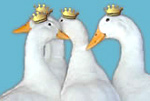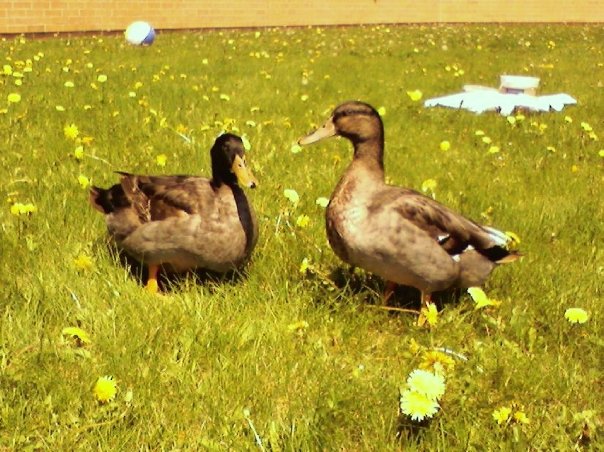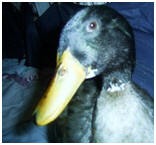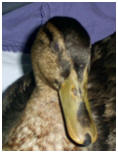Save The Bag
Many duck and goose owners pour their 50 lb. bags of feed into barrels or bins for easy access and safe storage and then throw away the bag.
When you empty your feed bags into barrels, write the complete lot/batch number on your calendar. As we've all recently witnessed, some recalls can occur months after your duck or goose has consumed the feed. Will you remember what they've eaten? Good record keeping can bring instant peace of mind, or it can provide detailed information for you and your veterinarian.
Nelly-Nell,
Young Jeffrey, Alice & Jodie-Dee chat about
the recall
Recall Research
In addition to visiting a company's webpage for recall information, you can visit FDA's website to find information regarding current recalls.
Feed Brands and Quality Control
The first step in researching your feed options is to do some internet research. Then CALL your grain company and other grain companies and ask them questions. You can't always know how good your own brand is until you compare it with others.
-
Check their reputation by researching their parent company
-
Find out about their in-house Quality Control procedures
-
Ask them questions about their suppliers
-
Find out where the grain is milled
-
Find out what else is produced at this mill
-
Find out what drugs may be used at this mill
-
Ask them about "Sequential production" of their grain
Sequential production is an important question if the grain mill also produces feed for other species of animals whose diet is different enough from your pet's diet, that batch-to-batch contamination could make your pet sick.
In other words, if they're bagging medicated monkey food right before they bag your duck food and a few kibbles accidentally spill over into your bag, you want to know that those monkey kibbles won't hurt your duck or goose if accidentally ingested.
Quality sequential production means that companies purposefully order the production of their various feed lines in such a way that any minor run-over from batch-to-batch should be absolutely safe for your pet.
Some basic Quality Control questions:
-
What kind of in-house QC testing do they routinely perform?
-
Do they test every ingredient?
-
Do they test every batch they mix?
-
Are their ingredients sourced in the U.S.?
-
Which of their ingredients are sourced from other countries?
-
Which ingredients are certified as tested by their suppliers?
-
Do they check up on their supplier's QC practices? How often?
-
Do they quality test any of their suppliers' ingredients?
-
Which ingredients are not tested and why?
-
What kind of consumer guarantees do they offer?
Keep in mind, the more tests they do, the more expensive your feed will be. Companies can't test for everything or their feed would be unaffordable for most of us. But are they covering the basics? The things you're concerned about? You have to ask.
Other things we like to keep in mind... How helpful were they? How educated were they about their own product? How was their customer service while you were on the phone? Do you think it will be better or worse in a time of crisis--if you ever have an issue with their feed?
Vitamin D Toxicity
As many of you know, Mazuri issued a voluntary recall for a variety of their animal feeds in July that included a batch of their Waterfowl Maintenance feed, which may have had up to four times the normal amount of vitamin D.
Fortunately our flock did not consume the recalled food. Those families who mix their Maintenance 50/50 with Breeder formula (because they have mixed flocks) likely avoided any problems as well.
Symptoms of excessive vitamin D include: loss of appetite and weight loss (anorexia), high calcium levels, joint stiffness, lethargy, organ mineralization and decreased kidney function.
If your duck or goose consumed effected feed (or if there is a chance they ate the feed, but you don't have your bag to confirm it), consult with your veterinarian especially if you are seeing any symptoms or changes in their behavior. Mazuri is also encouraging people to call them with any questions or concerns about your pet or their feed.
Your vet will likely want to run blood work on your duck or goose to check for elevated calcium levels and to ensure that all of their organs are functioning properly. You should have your results back in a few days, depending on which lab your vet uses.
Keep in mind calcium levels can be high if your duck or goose is on a diet that includes laying formula. If test results come back high, your vet will likely have the lab check their ionized calcium level (as opposed to blood calcium levels). High ionized calcium levels should be taken more seriously and lead you to do further testing.
Mazuri is recommending that animals suspected of having elevated Vitamin D levels get their levels checked. To the best of their knowledge, there is only one lab in the U.S. currently testing for 25 hydroxy D3 as an indicator of vitamin D status:
Heartland Assays lab in Ames, Iowa http://www.heartlandassays.com
We've heard that test results can take up to two weeks, making immediate dietary changes a wise precaution.
For a start, our vet recommends that birds with high ionized calcium levels be immediately fed a low calcium diet for at least three weeks (0.8 - 0.9% calcium feed). This means replacing any laying formula with a regular formula feed (and possibly even cutting that back with a percentage of cracked or whole corn if you can't find a brand with a calcium level in this range).
REMEMBER this is
only a temporary dietary change. Once
calcium levels are rechecked and back-to-normal,
your vet will likely advise you to slowly
increase calcium levels again (starting with 1.2
- 1.3% calcium feed and then raising them back
up to 2 - 3% laying feed).
Ask your vet whether or not calcium chips/oyster
shells should also be removed from your bird's
diet while on this program.
If you begin noticing soft eggshells as a result of reducing your bird's calcium levels, consult with our vet immediately. Ducks and geese have a pretty good instinct as to when they need to ingest added calcium (oyster shells/calcium chips) and most won't be interested in it when they have high levels of calcium already. This may mean it can be put out free choice again in a separate bowl, NOT mixed in with their regular food.
Our vet is not alone in advising that m
ost species (avian included) can tolerate 4-10 times higher than normal levels of Vitamin D for more than 60 days and up to 100 times the safe level of Vitamin D for less than 60 days. However, this being said, "tolerate" does not necessarily equate to being "symptom free."Something else you may need to consider is timing. Many ducks and geese are mid-molt or about to molt. That makes this a vital time for nutrients and vitamin fortification. The feathers they grow now need to last them an entire year, so whatever feed you choose, make it a good one. A few additional brand name choices include: Nutrena NatureWise, Purina and Blue Seal.
Ultimately, what you feed your pet is a personal decision, we only recommend that you make an informed decision. These are your pets and they are depending on you--whatever you choose.
Vitamin D Detox: Fortified vs. Non-fortified
Diets
If your pet duck or goose consumed excess levels
of Vitamin D from recalled feed, does their diet
need to be changed? And if so, how?
This is a question that nutritionists and
veterinarians are currently disagreeing upon.
And ultimately, many pet owners are having to make
choices based on conflicting information.
Some vets are advising not to pull
fortified food away from ducks and geese who've
eaten the recalled feed. They're advising that
pet owners whose birds ate the recalled food for
4-6 weeks merely reduce the calcium levels in their
diet for 3-4
weeks to reverse the effects. On the other hand, some
nutritionists are recommending that birds who've
eaten the recalled food for a similar amount of
time be placed on non-fortified diets for 4-8
weeks to reduce the intake of vitamin D and
calcium intake.
These are very different viewpoints that leave
pet owners wondering what to do. What do we
think here? Before confirming that none of
our ducks and geese consumed recalled food, our
vet advised us to keep all of our ducks and
geese on vitamin fortified diets because
it helps them maintain good health, which is the
best defense against illness and we found this
advice made good sense.
Even so, not everyone agrees. Some are arguing
in favor of non-fortified diets, reducing the overall intake of
vitamin D and calcium during the recovery
period. Detox diets of this nature should not be
confused with home remedies and should come
from a reliable and qualified source--that is,
from an individual certified in Animal/Bird
Nutrition and who can produce proof of their
certification upon request. Diets of this nature
should be followed exclusively and exactly.
Pet owners would be wise to provide your vet with the
precise details of whatever diet you choose
before beginning to verify its safety. Your vet
can also advise how long your bird should remain
on this diet based on their weight, medical
history and how much recalled food they have
ingested. Keep in mind, their diet should NOT be
entirely devoid of vitamin D--especially if they
spend a lot of time indoors or in a shady pen
(out of the sun), or you may be
adding
malnutrition to your duck or goose's list of
problems.
The bottom line
is, there just isn't one clear and simple answer
in all this because most people are in disagreement. This is a
time when we each need to review the facts and choose what we think
is right for ourselves and for our beloved
feathered companions.
To Feed or Not to Feed... What Feed?
Adding to all this feed confusion is the decision
over whether or not to continue feeding Mazuri
as your fortified feed of choice, or whether you
want to select a new brand. If selecting a new
brand, keep in mind that Purina Mills and Mazuri share
the same parent company (Land O'Lakes).
While Mazuri feels confident that they have
pinpointed the issue with their feed and know
exactly which batches were affected by the
ingredient source that was tainted with
vitamin D, not
everyone feels comfortable with their product at
this time. Since it's pretty common knowledge
that we serve Mazuri here at our sanctuary, we
have received numerous phone calls and emails
pertaining to this issue and these are some of
the relevant facts that we know: The
elevated vitamin D food was bagged between April
2nd
and May 8th.
Mazuri Breeder is considered unaffected because
it did not contain the ingredient in question.
The lab test results for the April 28th
Maintenance batch is a confirmed negative for
increased vitamin D levels, further
demonstrating that the issue has been isolated.
Mazuri is encouraging
pet owners to call them directly for more information
or for help in filing a claim to recover any vet and treatment costs.
As for ourselves, we are currently knee-deep in
product comparisons between Mazuri, Nutrena
NatureWise, Purina and Blue Seal products and
will provide more detailed information in our
upcoming September Newsletter. Our intention is
to provide ingredient comparisons, quality
control, milling comparisons and price
comparisons to see how they each stack up
against one other in the
hopes that this information will be helpful to
others as well.
A Chilly Idea
Ice is a great way
to cool down your kiddy pools and water buckets
in the heat of summer. You can find all kinds of
containers for making blocks of ice in your
freezer. Just be careful the ice isn't so big as
to cause any pinching (legs getting caught
between blocks of ice and their pool's edges).
Jenn at
Feathered Angels Sanctuary likes to take
empty 2 liter soda bottles, fill them with water
(leaving some room for expansion at the top) and
then freeze them without the caps. Once they're
frozen, she puts the caps back on and sets them
into their preformed duck ponds.
Geese especially LOVE this little trick because
it cools down their water and they
get to fiddle around and play with the bottle!
It's refreshing and a toy all in one!
Jocamo & Yolanda






